人教版七年级下册英语时态详解
- 格式:docx
- 大小:17.10 KB
- 文档页数:2

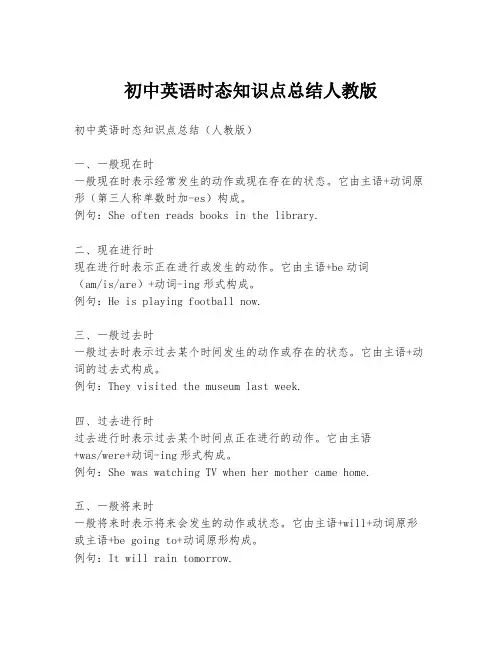
初中英语时态知识点总结人教版初中英语时态知识点总结(人教版)一、一般现在时一般现在时表示经常发生的动作或现在存在的状态。
它由主语+动词原形(第三人称单数时加-es)构成。
例句:She often reads books in the library.二、现在进行时现在进行时表示正在进行或发生的动作。
它由主语+be动词(am/is/are)+动词-ing形式构成。
例句:He is playing football now.三、一般过去时一般过去时表示过去某个时间发生的动作或存在的状态。
它由主语+动词的过去式构成。
例句:They visited the museum last week.四、过去进行时过去进行时表示过去某个时间点正在进行的动作。
它由主语+was/were+动词-ing形式构成。
例句:She was watching TV when her mother came home.五、一般将来时一般将来时表示将来会发生的动作或状态。
它由主语+will+动词原形或主语+be going to+动词原形构成。
例句:It will rain tomorrow.六、将来进行时将来进行时表示将来某个时间点正在进行的动作。
它由主语+will be+动词-ing形式构成。
例句:He will be working at this time tomorrow.七、现在完成时现在完成时表示过去发生的动作对现在造成的影响或结果,或者是从过去开始一直持续到现在的动作。
它由主语+have/has+动词的过去分词构成。
例句:I have finished my homework.八、现在完成进行时现在完成进行时表示从过去某一时间开始,一直持续到现在并可能继续下去的动作。
它由主语+have/has been+动词-ing形式构成。
例句:She has been studying English for five years.九、过去完成时过去完成时表示在过去某个时间点之前已经完成的动作。
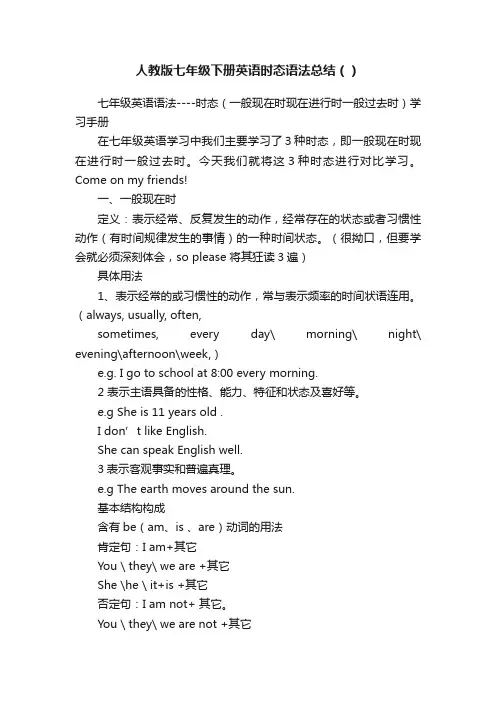
人教版七年级下册英语时态语法总结()七年级英语语法----时态(一般现在时现在进行时一般过去时)学习手册在七年级英语学习中我们主要学习了3种时态,即一般现在时现在进行时一般过去时。
今天我们就将这3种时态进行对比学习。
Come on my friends!一、一般现在时定义:表示经常、反复发生的动作,经常存在的状态或者习惯性动作(有时间规律发生的事情)的一种时间状态。
(很拗口,但要学会就必须深刻体会,so please 将其狂读3遍)具体用法1、表示经常的或习惯性的动作,常与表示频率的时间状语连用。
(always, usually, often,sometimes, every day\ morning\ night\ evening\afternoon\week,)e.g. I go to school at 8:00 every morning.2 表示主语具备的性格、能力、特征和状态及喜好等。
e.g She is 11 years old .I don’t like English.She can speak English well.3表示客观事实和普遍真理。
e.g The earth moves around the sun.基本结构构成含有be(am、is 、are)动词的用法肯定句:I am+其它You \ they\ we are +其它She \he \ it+is +其它否定句:I am not+ 其它。
You \ they\ we are not +其它She \he \ it+is +not +其它一般疑问句及回答:Are you +其它?肯定回答:yes, I am. 否定回答:no, I am not.Are you\ they\ you+ 其它?肯定回答: yes,we \they are. 否定回答:no, we \they are not.Is she\ he \it+其它?肯定回答: yes,she \he \it is. 否定回答:no,she \he \it is not.从上面结构中你能总结出be动词的用法吗?单数________,复数_________ ;我用_________,你用__________ ,______________-连着她他它。

初中英语学习材料madeofjingetieji英语时态详解一、一般过去时:1.概念:过去某个时间里发生的动作或状态;过去习惯性、经常性的动作、行为。
2.时间状语:ago, yesterday, the day before yesterday, last week(year, night, month…), in 1989, just now, at the age of 5, one day, long long ago, once upona time, etc.3.基本结构:be动词;行为动词4.否定形式:was/were+not;在行为动词前加didn't,同时还原行为动词。
5.一般疑问句:was或were放于句首;用助动词do的过去式did 提问,同时还原行为动词。
6.例句:She often came to help us in those days.I didn't know you were so busy.一般过去时一.用“am , is , was”填空1. I _____ a teacher now. I _____ a student five years ago.2. Where ______ it now?3. Where ______ it last Sunday?4. Yang Ling ______ at home now. But she ______ at school yesterday.二.用所给动词的适当形式填空1.Tom _______ (visit) a farm last week.2. The twins _______ (water) the flowers in the garden yesterday morning.3. I _______ (watch) a film with my friend last Friday.4. My father _______ (be) in London last year.5. What_______ (do) you do three days ago?6. _______ (be) there any parks here in 1950?7. What_________(do) you do just now? I __________ (wash) my clothes.三.用所给词的适当形式填空1. It ______ (be) there just now, but it isn’t there now.2. Where’s the camera? It ________ (is) there a moment ago.3. It _______ (be) Helen’s birthday yesterday.4. Tom _______(go ) to visit a farm last week.5. I _______ (watch) a film with my friend last Friday.6. My father _______ (be) in London last year.7. What_______ (do) you do three days ago?8. Where ______ (be) you just now?I _______ (be) in the classroom.9. What ______ you _______(do) last Friday?We ________(water) trees on the farm.二、现在进行时:1.概念:表示现阶段或说话时正在进行的动作及行为。
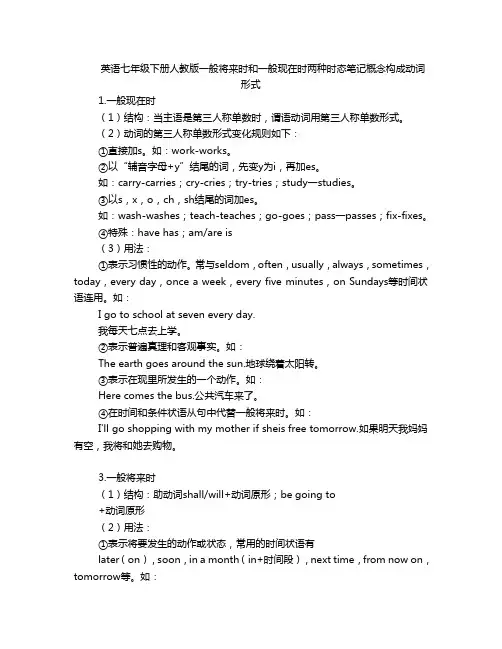
英语七年级下册人教版一般将来时和一般现在时两种时态笔记概念构成动词形式1.一般现在时(1)结构:当主语是第三人称单数时,谓语动词用第三人称单数形式。
(2)动词的第三人称单数形式变化规则如下:①直接加s。
如:work-works。
②以“辅音字母+y”结尾的词,先变y为i,再加es。
如:carry-carries;cry-cries;try-tries;study一studies。
③以s,x,o,ch,sh结尾的词加es。
如:wash-washes;teach-teaches;go-goes;pass一passes;fix-fixes。
④特殊:have has;am/are is(3)用法:①表示习惯性的动作。
常与seldom,often,usually,always,sometimes,today,every day,once a week,every five minutes,on Sundays等时间状语连用。
如:I go to school at seven every day.我每天七点去上学。
②表示普遍真理和客观事实。
如:The earth goes around the sun.地球绕着太阳转。
③表示在现里所发生的一个动作。
如:Here comes the bus.公共汽车来了。
④在时间和条件状语从句中代替一般将来时。
如:I'll go shopping with my mother if sheis free tomorrow.如果明天我妈妈有空,我将和她去购物。
3.一般将来时(1)结构:助动词shall/will+动词原形;be going to+动词原形(2)用法:①表示将要发生的动作或状态,常用的时间状语有later(on),soon,in a month(in+时间段),next time,from now on,tomorrow等。
如:I shall be eighteen years old next year.明年我就18岁了。
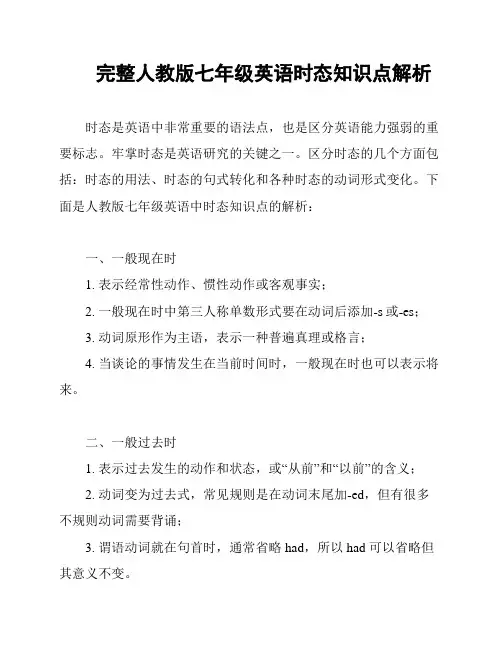
完整人教版七年级英语时态知识点解析时态是英语中非常重要的语法点,也是区分英语能力强弱的重要标志。
牢掌时态是英语研究的关键之一。
区分时态的几个方面包括:时态的用法、时态的句式转化和各种时态的动词形式变化。
下面是人教版七年级英语中时态知识点的解析:一、一般现在时1. 表示经常性动作、惯性动作或客观事实;2. 一般现在时中第三人称单数形式要在动词后添加-s或-es;3. 动词原形作为主语,表示一种普遍真理或格言;4. 当谈论的事情发生在当前时间时,一般现在时也可以表示将来。
二、一般过去时1. 表示过去发生的动作和状态,或“从前”和“以前”的含义;2. 动词变为过去式,常见规则是在动词末尾加-ed,但有很多不规则动词需要背诵;3. 谓语动词就在句首时,通常省略 had,所以 had 可以省略但其意义不变。
三、一般将来时1. 表示将来的动作或存在的状态,意义上相当于“将要”;2. 一般将来时通常要用助动词will(shall),用于第一人称时,也可以使用 shall;3. “be going to+动词原形”也是表示将来的另一种方式。
四、现在进行时1. 表示现在正在进行或发生的动作;2. 由“be +现在分区”构成,be 动词的形式与主语一致,现在分词则在动词原形后添加-ing;3. 时间状语:now,at present,right now 等,用于强调正在发生的动作。
五、过去进行时1. 表示过去某一时刻正在进行的动作;2. 由“was / were+现在分词”构成,was / were 动词的形式与主语一致,现在分词则在动词原形后添加-ing;3. 时间状语:at that time,at six o’clock yesterday evening 等。
六、将来进行时1. 表示“将来某一时刻正在进行的动作”;2. 由“will be +现在分词”构成;3. 这种时态比较少见,常被其他时态所替代。
七、现在完成时1. 表示过去某个不确定的时间开始,持续到现在还未结束的动作;2. 由“have / has +过去分词”构成,have 和 has 用于不同的人称,动词的过去分词形式在常规情况下为动词原形+ed,但也有很多特殊情况需要特别记忆。
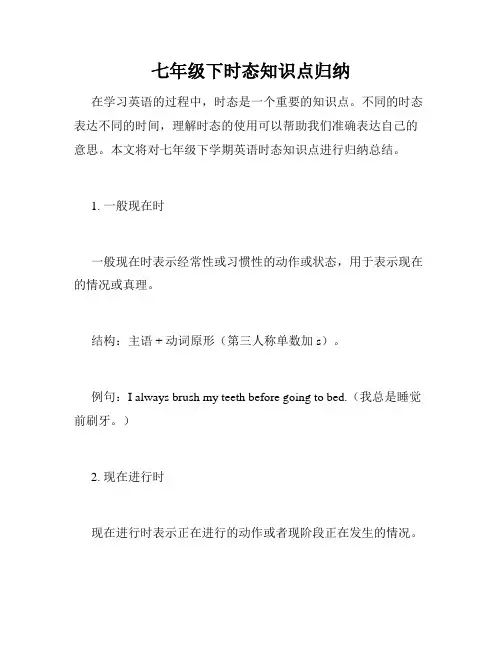
七年级下时态知识点归纳在学习英语的过程中,时态是一个重要的知识点。
不同的时态表达不同的时间,理解时态的使用可以帮助我们准确表达自己的意思。
本文将对七年级下学期英语时态知识点进行归纳总结。
1. 一般现在时一般现在时表示经常性或习惯性的动作或状态,用于表示现在的情况或真理。
结构:主语 + 动词原形(第三人称单数加s)。
例句:I always brush my teeth before going to bed.(我总是睡觉前刷牙。
)2. 现在进行时现在进行时表示正在进行的动作或者现阶段正在发生的情况。
结构:主语 + am/is/are + doing。
例句:I am reading a book now.(我正在看书。
)3. 一般过去时一般过去时表示过去发生的动作或状态。
结构:主语 + 动词的过去式。
例句:He played football yesterday.(他昨天踢足球。
)4. 过去进行时过去进行时表示过去某一时间正在进行的动作。
结构:主语 + was/were + doing。
例句:We were studying English at this time last night.(昨晚这个时候我们在学英语。
)5. 一般将来时一般将来时表示将来的某个时间会发生的动作或状态。
结构:主语 + will/shall + 动词原形。
例句:I will go to school tomorrow.(我明天上学。
)6. 现在完成时现在完成时表示过去发生的动作对现在产生的影响或结果。
结构:主语 + have/has + 过去分词。
例句:I have finished my homework.(我已经完成了我的作业。
)7. 过去完成时过去完成时表示在过去某一时刻之前已经完成的某个动作或状态。
结构:主语 + had + 过去分词。
例句:By the time I got home, he had already left.(当我回家时,他已经离开了。

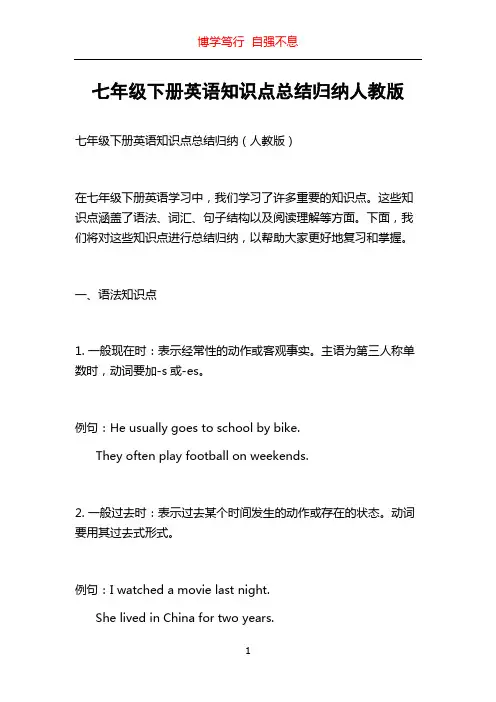
七年级下册英语知识点总结归纳人教版七年级下册英语知识点总结归纳(人教版)在七年级下册英语学习中,我们学习了许多重要的知识点。
这些知识点涵盖了语法、词汇、句子结构以及阅读理解等方面。
下面,我们将对这些知识点进行总结归纳,以帮助大家更好地复习和掌握。
一、语法知识点1. 一般现在时:表示经常性的动作或客观事实。
主语为第三人称单数时,动词要加-s或-es。
例句:He usually goes to school by bike.They often play football on weekends.2. 一般过去时:表示过去某个时间发生的动作或存在的状态。
动词要用其过去式形式。
例句:I watched a movie last night.She lived in China for two years.3. 现在进行时:表示说话时正在进行的动作。
构成:主语+be动词(am, is, are)+动词-ing。
例句:They are playing basketball in the park.We are learning English now.4. 一般将来时:表示将来要发生的动作或存在的状态。
构成:主语+will+动词原形。
例句:I will visit my grandparents next weekend.She will be a doctor in the future.5. 情态动词:can, may, must等,表示能力、许可、必须等。
例句:You can go to the park with us.Students must wear school uniforms.6. 宾语从句:用来充当主句中动词的宾语的从句。
例句:I think that he is a good student.She knows where the nearest supermarket is.二、词汇知识点1. 动词短语:由动词与副词/介词组成的短语。
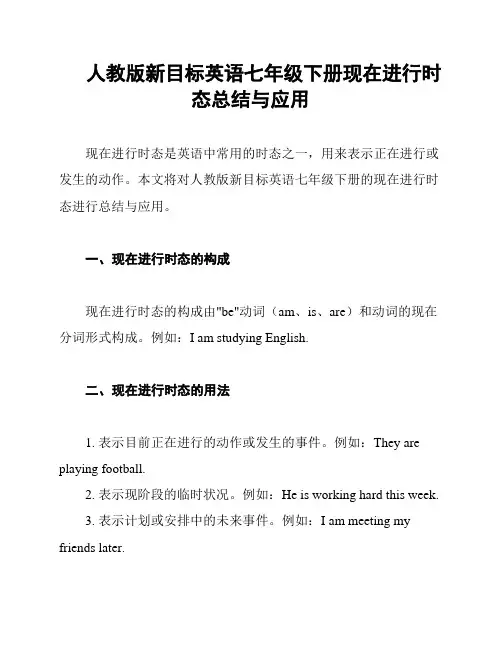
人教版新目标英语七年级下册现在进行时态总结与应用现在进行时态是英语中常用的时态之一,用来表示正在进行或发生的动作。
本文将对人教版新目标英语七年级下册的现在进行时态进行总结与应用。
一、现在进行时态的构成现在进行时态的构成由"be"动词(am、is、are)和动词的现在分词形式构成。
例如:I am studying English.二、现在进行时态的用法1. 表示目前正在进行的动作或发生的事件。
例如:They are playing football.2. 表示现阶段的临时状况。
例如:He is working hard this week.3. 表示计划或安排中的未来事件。
例如:I am meeting my friends later.三、现在进行时态的标志词语现在进行时态常与以下标志词语一起使用:- now:现在- at the moment:此刻- currently:目前- right now:现在- look!:看!四、现在进行时态的句型结构肯定句:主语 + am/is/are + 现在分词否定句:主语 + am/is/are + not + 现在分词疑问句:Am/Is/Are + 主语 + 现在分词?例如:- Affirmative: I am studying English.- Negative: She is not playing tennis.- Interrogative: Are you watching TV?五、现在进行时态的常见错误1. 错误使用动词的现在分词形式。
例如:He is go to school.(正确:He is going to school.)2. 错误使用"be"动词的形式。
例如:They am playing basketball.(正确:They are playing basketball.)3. 错误使用肯定/否定/疑问结构。
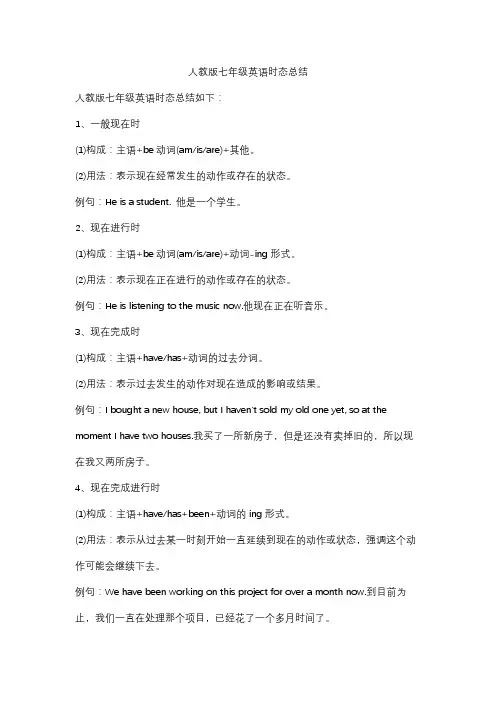
人教版七年级英语时态总结人教版七年级英语时态总结如下:1、一般现在时(1)构成:主语+be动词(am/is/are)+其他。
(2)用法:表示现在经常发生的动作或存在的状态。
例句:He is a student. 他是一个学生。
2、现在进行时(1)构成:主语+be动词(am/is/are)+动词-ing形式。
(2)用法:表示现在正在进行的动作或存在的状态。
例句:He is listening to the music now.他现在正在听音乐。
3、现在完成时(1)构成:主语+have/has+动词的过去分词。
(2)用法:表示过去发生的动作对现在造成的影响或结果。
例句:I bought a new house, but I haven't sold my old one yet, so at the moment I have two houses.我买了一所新房子,但是还没有卖掉旧的,所以现在我又两所房子。
4、现在完成进行时(1)构成:主语+have/has+been+动词的ing形式。
(2)用法:表示从过去某一时刻开始一直延续到现在的动作或状态,强调这个动作可能会继续下去。
例句:We have been working on this project for over a month now.到目前为止,我们一直在处理那个项目,已经花了一个多月时间了。
5、一般过去时(1)构成:主语+动词的过去式。
(2)用法:表示过去某个时间发生的动作或存在的状态。
例句:I bought some fruits yesterday.我昨天买了一些水果。
6、过去进行时(1)构成:主语+was/were+动词-ing形式。
(2)用法:表示过去某个时间正在进行的动作或存在的状态。
例句:I was travelling in London last summer vacation.去年暑假我在伦敦旅行。
7、过去完成时(1)构成:主语+had+动词的过去分词。
初一下英语四个说讲解
初一下英语四个说讲解如下:
1. "一般现在时" 表示通常的情况或恒定的状态。
结构:主语 + 谓语动词 + 其他成分
例子:I have a cat. (我有一个猫)
2. "现在进行时" 表示正在进行的动作或正在发生的事情。
结构:主语 + 助动词be + 谓语动词-ing + 其他成分
例子:He is playing the guitar. (他正在弹吉他)
3. "一般将来时" 表示未来的动作或状态。
结构:主语 + 谓语动词 + 宾语 + 其他成分
例子:I will go to the park tomorrow. (我明天会去公园)
4. "现在完成时" 表示已经完成的动作或经验。
结构:主语 + 谓语动词的完成时 + 其他成分
例子:They have already finished their homework. (他们已经完成了作业)
以上就是初一下英语中常见的四个时态的讲解,希望对你有所帮助。
人教版英语七年级下册教材详解1、1)live on 以…为食;以…为生Tigers live on meat.2)live in 住在某地He lives in Beijing.2、dislike 不喜欢(=don’t/doesn’t/didn’t like)如:I dislike to go to the cinema.3、重点句子1)Where is he from ? = Where does he come from?2)He is from Japan. = He doesn’t come from Japan.3)Where does he live ? ----He lives in Tokyo.4)Please write to me soon. (write to sb. 写信给某人= write a letter to sb.)Unit 21、street 表“街道”,短语:on/ in the street 在街道上。
2、介词短语⑴ near 在…附近⑵ next to 紧挨着⑶ across from在…对面⑷ between ….and… 在A和B之间⑸ in front of 在…外面的前面:There is a tree in front of a house.⑹ in the front of在…里面的前面:The teacher is in the front of the classroom.⑺ behind 在…外面的后面:The ball is behind the door.⑻ in the back of 在…里面的后面My friend sits in the back of the classroom.3、through, across,over, 和past都是介词,不能单独做谓语,必须与动词连用才能做谓语。
1)through 从物体内部穿过,如:walk through a forest. 穿过一个森林2)past 从物体外面绕过, 如:walk past a post office 经过一个邮局3)across 从物体表面横穿,如:go across the road 横穿马路4)over 从物体上空越过, 如:fly over the city 飞过城市【注意】pass(经过),cross (横穿) 都是动词,可作谓语,相当于“动词+past/across”.如:①I pass (walk past) a post office every day. ② Don’t cross (walk across) the road.4、straight ⑴形容词,笔直的,直的:She has straight hair. 她长着直发。
完整人教版七年级英语时态语法讲解七年级英语语法——时态讲解及练时态定义:表示经常、反复发生的动作、经常存在的状态或者惯性动作(有时间规律发生的事情)的一种时间状态。
具体用法:1.表示经常的或惯性的动作,常与表示频率的时间状语连用(always。
usually。
often。
sometimes。
everyday。
morning。
night。
evening。
afternoon。
week)。
例如:I go to school at 8 every morning.2.表示主语具备的性格、水平、特征和状态及喜好等。
例如:She is 11 years old。
I don’t like English。
She can speak English well.3.表示客观事实和普遍真理。
例如:XXX around the sun.基本结构构成:含有be(am、is、are)动词的用法:肯定句:I am + 其它,You/they/we are + 其它,She/he/it is + 其它。
否定句:I am not + 其它,You/they/we are not + 其它,She/he/it is not + 其它。
一般疑问句及回答:Are you + 其它?肯定回答:Yes。
I am。
否定回答:No。
I am not。
Are you/they/you + 其它?肯定回答:Yes。
we/they are。
否定回答:No。
we/they are not。
Is she/he/it + 其它?肯定回答:Yes。
she/he/it is。
否定回答:No。
she/he/it is not。
从上面结构中你能总结出be动词的用法吗?单数用is,复数用are;我用am,你用are,连着她他它用is。
含实义动词的结构:肯定句:主语(I。
we。
you。
they)+动词原形+其它。
否定句:主语(I。
we。
you。
they)+don’t+动原+其它。
英语时态详解
一、一般过去时:
1.概念:过去某个时间里发生的动作或状态;过去习惯性、经常性的动作、行为。
2.时间状语:ago, yesterday, the day before yesterday, last week(year, night, month…), in 1989, just now, at the age of 5, one day, long long ago, once upon
a time, etc.
3.基本结构:be动词;行为动词
4.否定形式:was/were+not;在行为动词前加didn't,同时还原行为动词。
5.一般疑问句:was或were放于句首;用助动词do的过去式did 提问,同时还原行为动词。
6.例句:She often came to help us in those days.
I didn't know you were so busy.
一般过去时
一.用“am , is , was”填空
1. I _____ a teacher now. I _____ a student five years ago.
2. Where ______ it now?
3. Where ______ it last Sunday?
4. Yang Ling ______ at home now. But she ______ at school yesterday.
二.用所给动词的适当形式填空
1.Tom _______ (visit) a farm last week.
2. The twins _______ (water) the flowers in the garden yesterday morning.
3. I _______ (watch) a film with my friend last Friday.
4. My father _______ (be) in London last year.
5. What_______ (do) you do three days ago?
6. _______ (be) there any parks here in 1950?
7. What_________(do) you do just now? I __________ (wash) my clothes.
三.用所给词的适当形式填空
1. It ______ (be) there just now, but it isn’t there now.
2. Where’s the camera? It ________ (is) there a moment ago.
3. It _______ (be) Helen’s birthday yesterday.
4. Tom _______(go ) to visit a farm last week.
5. I _______ (watch) a film with my friend last Friday.
6. My father _______ (be) in London last year.
7. What_______ (do) you do three days ago?
8. Where ______ (be) you just now?
I _______ (be) in the classroom.
9. What ______ you _______(do) last Friday?
We ________(water) trees on the farm.
二、现在进行时:
1.概念:表示现阶段或说话时正在进行的动作及行为。
2.时间状语:now, at this time, these days, etc.
3.基本结构:am/is/are+doing
4.否定形式:am/is/are+not+doing.
5.一般疑问句:把be动词放于句首。
6.例句:How are you feeling today?
He is doing well in his lessons.
现在进行时
一、选择填空
( )1.Look!The twins_____their mother do the housework.
(A)are wanting (B)help
(C)are helping (D)are looking
( )2._____are the birds doing? They are singing in a tree.
(A)Who (B)What
(C)How (D)Where
( )3.What are you listening_____?
(A)/ (B)for
(C)at (D)to
( )4.Listen! She____in the classroom.
(A)is singing (B)sing
(C)to sing (D)is sing
( )5.Today Jim______ his white shirt and brown trousers.
(A)is putting on (B)wear
(C)put on (D)is wearing
二、用所给的动词的正确形式填空
1.The boy __________(draw)a picture now.
2. Listen!Some girls _______________ ( sing)in the classroom .
3. My mother _________________ ( cook )some nice food now.
4. What ________ you ______ ( do ) now?
5. Look!They _________( have) an English lesson .
6.They ____________(not ,water) the flowers now.
7.Look! the girls ____________(dance )in the classroom .
8.What is our granddaughter doing? She _________(listen ) to music.
9. It’s 5 o’clock now. We _____________(have)supper now.
10.______Helen____________(wash )clothes? Yes ,she is.。